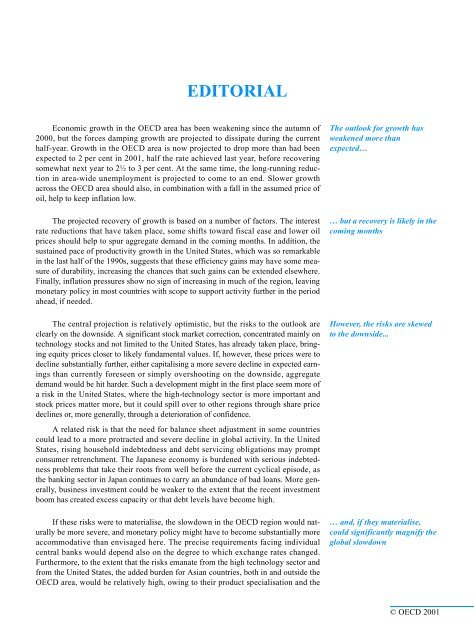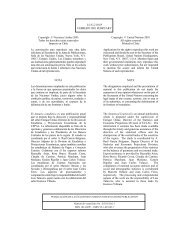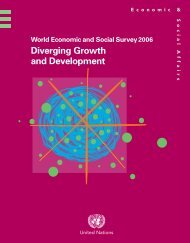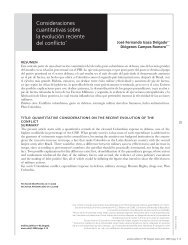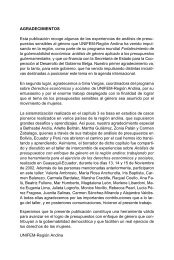OECD Economic Outlook 69 - Biblioteca Hegoa
OECD Economic Outlook 69 - Biblioteca Hegoa
OECD Economic Outlook 69 - Biblioteca Hegoa
You also want an ePaper? Increase the reach of your titles
YUMPU automatically turns print PDFs into web optimized ePapers that Google loves.
EDITORIAL<br />
<strong>Economic</strong> growth in the <strong>OECD</strong> area has been weakening since the autumn of<br />
2000, but the forces damping growth are projected to dissipate during the current<br />
half-year. Growth in the <strong>OECD</strong> area is now projected to drop more than had been<br />
expected to 2 per cent in 2001, half the rate achieved last year, before recovering<br />
somewhat next year to 2½ to 3 per cent. At the same time, the long-running reduction<br />
in area-wide unemployment is projected to come to an end. Slower growth<br />
across the <strong>OECD</strong> area should also, in combination with a fall in the assumed price of<br />
oil, help to keep inflation low.<br />
The projected recovery of growth is based on a number of factors. The interest<br />
rate reductions that have taken place, some shifts toward fiscal ease and lower oil<br />
prices should help to spur aggregate demand in the coming months. In addition, the<br />
sustained pace of productivity growth in the United States, which was so remarkable<br />
in the last half of the 1990s, suggests that these efficiency gains may have some measure<br />
of durability, increasing the chances that such gains can be extended elsewhere.<br />
Finally, inflation pressures show no sign of increasing in much of the region, leaving<br />
monetary policy in most countries with scope to support activity further in the period<br />
ahead, if needed.<br />
The central projection is relatively optimistic, but the risks to the outlook are<br />
clearly on the downside. A significant stock market correction, concentrated mainly on<br />
technology stocks and not limited to the United States, has already taken place, bringing<br />
equity prices closer to likely fundamental values. If, however, these prices were to<br />
decline substantially further, either capitalising a more severe decline in expected earnings<br />
than currently foreseen or simply overshooting on the downside, aggregate<br />
demand would be hit harder. Such a development might in the first place seem more of<br />
a risk in the United States, where the high-technology sector is more important and<br />
stock prices matter more, but it could spill over to other regions through share price<br />
declines or, more generally, through a deterioration of confidence.<br />
A related risk is that the need for balance sheet adjustment in some countries<br />
could lead to a more protracted and severe decline in global activity. In the United<br />
States, rising household indebtedness and debt servicing obligations may prompt<br />
consumer retrenchment. The Japanese economy is burdened with serious indebtedness<br />
problems that take their roots from well before the current cyclical episode, as<br />
the banking sector in Japan continues to carry an abundance of bad loans. More generally,<br />
business investment could be weaker to the extent that the recent investment<br />
boom has created excess capacity or that debt levels have become high.<br />
If these risks were to materialise, the slowdown in the <strong>OECD</strong> region would naturally<br />
be more severe, and monetary policy might have to become substantially more<br />
accommodative than envisaged here. The precise requirements facing individual<br />
central banks would depend also on the degree to which exchange rates changed.<br />
Furthermore, to the extent that the risks emanate from the high technology sector and<br />
from the United States, the added burden for Asian countries, both in and outside the<br />
<strong>OECD</strong> area, would be relatively high, owing to their product specialisation and the<br />
The outlook for growth has<br />
weakened more than<br />
expected…<br />
… but a recovery is likely in the<br />
coming months<br />
However, the risks are skewed<br />
to the downside...<br />
… and, if they materialise,<br />
could significantly magnify the<br />
global slowdown<br />
© <strong>OECD</strong> 2001


